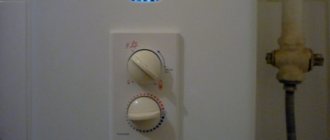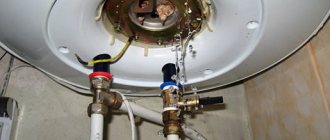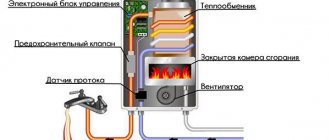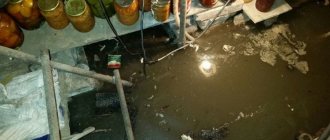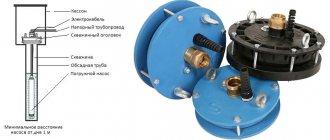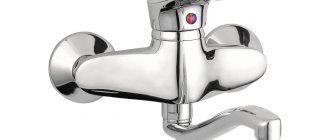The column or flow heater is becoming an increasingly popular product. A small device can fit compactly in the kitchen and provide hot water to several points of intake. In addition, heating with gas is cheaper than heating with electricity. But what to do if the gas water heater is leaking? Should I call a professional or figure out the problem myself? Possible options are indicated in the article.
Why is the geyser leaking - what to do
If there is no maintenance, after 4-5 years of operation, you may suddenly encounter water starting to drip from your instantaneous gas water heater. Leaks occur for several reasons.
Some problems are easy to fix yourself. Others require skilled maintenance. If the owner is faced with the fact that his gas water heater is leaking, there are several important points to consider:
- Is it possible to use a faulty water heater?
what causes the leak;
- methods for eliminating leaks and increased condensation formation.
Regardless of how intensely water drips from the boiler, it is necessary to determine the cause of the leak and eliminate it immediately.
Is it possible to use the column if it leaks?
Only serviceable, operational gas-consuming equipment is allowed for operation. It is prohibited to use a gas water heater if it is dripping. There are several consequences of turning on a faulty water heater:
there is a high probability of the burner flooding with water from the heat exchanger, which leads to an explosion and gas poisoning (if the combustion control function is missing or faulty in the column);
If the leak was caused by a malfunction of the water unit, the automatic gas water heater simply will not start. The block is connected to the ignition system and gas valve. A leak indicates a malfunction of the gearbox and often after a short period of time leads to complete failure of the water heater.
Technical reasons for column leakage
There are two main failures that lead to leaks. The malfunction is determined by the method of exclusion. The breakdown is indicated by the localization of the appearance of liquid. So, if water flows from below, most likely the malfunction is associated with a failure of the gearbox. When condensation appears, the breakdown is associated with the heat exchanger.
Below is a description of common problems:
- The malfunction of the water unit is a gearbox, a simple control device that sends a signal to open the gas valve and to the ignition unit. Inside, the “frog” is a hollow structure divided in half by a membrane. When water is supplied to the reducer, pressure is applied to the diaphragm, which in turn leads to the movement of the rod connected to the gas valve. The membrane fails due to prolonged pressure and mechanical stress. Signs of a breakthrough:
- water drips from the safety valve of the gas water heater - the membrane blocks the access of liquid, but the barrier disappears after damage or wear of the gasket;
- the water unit is leaking - another clear sign of failure of the membrane or rod seal. Initially, only a few drops of water are released during operation. Over time, the flow in the frog becomes more intense.
Corrosion or hole in the heat exchanger (radiator) - the steel or copper tubes of the coil are subject to constant thermal stress. As a result of direct exposure to fire, microcracks form on the metal surface. Burnout of the tubes occurs. The first sign of failure is the accumulation of condensation on the body and internal components of the water heater. In places of leakage, copper changes color to poisonous green.
To eliminate a leak, you must determine its root cause. For this purpose, remove the boiler casing and carry out a visual inspection. Work begins after determining the location and intensity of the leak. Before servicing, turn off the gas and water supplies.
Difficulties in repairing different speaker models
If we take into account geysers of all brands and models, then the causes of leakage are almost the same. However, if we consider the brands of devices separately, we can point out certain breakdowns that more often occur in the gas water heater of a particular manufacturer.
Let's look at the example of brands popular among buyers. If you are using one of the columns discussed below and it is leaking, then it will be easier for you to find the cause of the leak.
Causes of leakage of Neva columns
If the Neva geyser is flooded with water, the leak is caused by the following defects:
- membrane malfunction;
- the stem seal is leaking;
- The integrity of the rod plate is compromised.
Speaking about this brand of gas boilers, it should be noted that it is very problematic to eliminate a leak in the stem seal. The difficulty is caused by the connecting bolts of the two compartments - gas and water. They are quite difficult to unscrew. Often, when trying to carry out repairs, the bolts break.
Budget-type models of this brand, which are automatic, for example Neva 5410, often leak due to heat exchanger failures. The reason is the aluminum body, which means a low level of material strength
Leak in Junkers geysers
Liquid leakage in a Junkers heater occurs more often for the following reasons:
- radiator failure;
- damage to the sealing rings - in older models they dry out, which leads to the formation of a leak from the column;
- formation of cracks in the flow regulator (place of attachment of the “frog”);
- natural wear of the membrane.
In the first case, it will be necessary to carry out soldering work; in the second and possibly the third, it will be necessary to replace the O-rings.
It is better to disassemble the Junkers column if a leak occurs by dismantling this unit. Since in the vast majority of cases, failure is associated with wear of the membrane and cover. They will probably need to be replaced
Problems with Ariston water heaters
Those who have a column talk about leaks in the lower part of the device. The problem lies in the wear of the flange gasket . The problem is solved by replacing it. To do this, disconnect the column from the network and drain all the water. Afterwards the cover is removed, the flange is removed and the same gasket is replaced.
Another problem with these columns is depressurization of the connection areas . The best solution is to cover the joints with sealant.
Reasons for leaking speakers of other brands
Service centers are more often confronted with clients who owns the dispenser. And, almost always, leakage is caused by wear of the membrane . For this reason, experts recommend keeping this part in stock. And promptly clean the device from scale and dirt.
Oasis geysers are leaking due to a faulty stem seal, which needs to be replaced. We discussed this process in more detail, as well as a review of other breakdowns of speakers of this brand and methods for repairing them in our other article.
Columns begin to leak most often for two reasons - defects at the joints and a leaky heat exchanger. A temporary solution to the problem is soldering copper tubes; a more effective and long-lasting solution is to replace the radiator.
How to fix a leak in a column
First, identify the source of the leak. This can be done quite simply by visual inspection. The casing is attached with latches or fixed with bolts. If water drips from the geyser only when you turn it on, you will need to start heating the water for a few seconds. After identifying the location of the breakdown, they begin to eliminate the leak:
- Threaded and other connections - leaks are eliminated by changing all the gaskets and re-packing the connection. To improve sealing, special silicone compounds (sealants) are used. If a hose leaks, it must be replaced; it cannot be repaired. The average service life of gaskets is 2-4 years. You can prevent leakage by carrying out regular maintenance of the water heater, with the replacement of all sealing rubber bands.
You can eliminate leaks at threaded connections yourself. Repairing a “frog” requires certain technical skills and a clear understanding of how the water unit works.
Condensate in a gas water heater - what to do
In this case, the problem is more serious. Most likely there is a leak in the heater. Occurs under the influence of small microcracks. Initially, perspiration appears on the body and internal parts of the speaker. Subsequently, condensation begins to drip from the gas water heater.
A heater (radiator, coil or heat exchanger) consists of pipes with fins. When exposed to direct fire, the metal will burn out over time. Thinning pipe walls lead to leaks and condensation. The malfunction must be corrected immediately. Replacing the radiator or soldering the damaged area will help get rid of condensation.
Soldering is performed in the following way:
- the liquid from the heat exchanger is drained;
remove all dirt and scale from the surface;
Radiator clogged
You can find out complete information on the selection, operation and maintenance of gas water heaters (instantaneous water heaters) from all manufacturers if you go.
In addition to specific information on the site, you can also study specific problems from other people on this topic who have already purchased a gas water heater or instantaneous water heater and thus avoid them. You will find a regularly updated list of such problems and their solutions.
The heat exchanger radiator consists of pipes and metal plates located close to each other. The plates are in direct contact with the flame, so soot accumulates on them over time.
You can determine that this is a problem by the following indicators:
- Yellow color of flame.
- The fire tends not upward, but to the side, heating the body.
- When operating at full power, the water heats up slightly.
- Soot is pouring out from under the column.
In order to clean it, you need to remove the heat exchanger. To do this, remove the casing and unscrew all the elements that hold it. During disassembly, cover the burner with a rag to prevent soot from getting into it.
After removal, the knot is carried to the bathroom and washed there. It is best to leave it in a container with high sides for several hours to allow the soot to soften. Next, the space between the fins of the heat exchanger is cleaned under running water using a long-hair brush and detergents. At the end, drying and installation is carried out in the reverse order.
What to do if the gas water heater is leaking?
The phrase “gas water heater” usually refers to a flow-through gas water heater, which is installed to heat water in houses not connected to centralized heating. This heating method has many advantages, the most important of which is independence from utilities and maintenance work, which allows you to always have heat and hot water in the house.
However, residents of houses connected to the gas pipeline also have many problems. One of the most common troubles is the breakdown of gas equipment, which can lead to very serious and even life-threatening consequences. Read about what to do if you find a leak in a gas water heater in our article today.
Conclusions and useful video on the topic
Often the problem of geyser heat exchanger leakage is eliminated by soldering tubes. However, not everyone will have the necessary tools and materials in their home. There is an alternative way to solve the problem - without soldering. How to do this, see the following video:
Fixing a leak in a water heater of any brand is not a complicated procedure - all the work can be done independently, having a standard set of tools in the house. To do this, it is not necessary to have special skills and knowledge, but simply use the instructions given above and do not forget about the safety rules when using gas equipment.
And if during the process of carrying out repairs with your own hands you discover a gas leak, you should immediately call the gas specialists.
Would you like to tell us about your own experience of eliminating a gas water heater leak? Or do you have your own opinion about the advisability of independently searching for the cause of the leak and further repairs on your own? Express your opinion, share your experience, participate in discussions - the comment form is located below.
Why is it leaking?
We have compiled a list of the most common reasons why a gas water heater begins to leak. So, if you suspect a leak, then perhaps the reason will be one of the following:
- The connecting elements of the water flow are worn out. That is, in other words, the rubber sealing gaskets located between the hose and the pipe need to be replaced.
- The heat exchanger, that is, a kind of “tank” in which the water is heated, burst. The pipes connected to it are constantly subject to temperature changes, as a result of which they can become deformed and corrode.
- Regular preventative maintenance was not carried out. A geyser is equipment that requires periodic inspection and maintenance to prevent breakdowns. If you neglect these duties, a leak may appear unexpectedly.
How to fix a leak?
Having discovered the cause of the leak, you can begin to eliminate it. Our further actions will depend on which part of the gas water column is the source of the leak.
Radiator leak
The fact that there is a crack or hole in the radiator is indicated by the presence of green spots on this part. The procedure for eliminating a leak in the radiator will be as follows:
- We shut off the water pipes to prevent water from entering the column. Disconnect the water supply hoses from the column. Drain the remaining water from the radiator. To remove liquid from the coil, use a vacuum cleaner or pump.
- Armed with sandpaper, we clean the damaged areas. Then we treat these areas with a degreasing solution and wipe them dry.
- We take a soldering iron with solder, which can be used at temperatures above 180 degrees (the power of the soldering iron must be at least 100 W). Grind a piece of rosin or grind an aspirin pill into powder. Sprinkle this mixture onto your work surface.
- Having heated the soldering iron to the desired temperature, we increase the solder to a height of approximately 0.2 cm.
- We repeat this procedure for each through damage.
Alexander Gerasimov in his video will show and tell you how to properly solder a geyser radiator yourself.
Leakage in threaded connections
Quite often you can detect leaks in the threaded connections between parts of the gas water heater. Pay attention to which pipe has a leak: the left pipe usually supplies water for heating, and the right pipe usually supplies gas. As a rule, water begins to leak from the pipe if the sealing gasket is worn out. Changing this part is very easy.
- The first thing to do is block the water supply.
- Then we disassemble the connection in which the problem is detected (we use a regular wrench for this purpose). We remove the worn gasket.
- We clean the connecting elements from dirt and degrease them.
- If the thread on the American nut is damaged, it should be replaced.
- Then we install a new rubber gasket and assemble the connection.
Leaking pipes
Sometimes a leak is found not in the connection of the tubes, but directly in them themselves. Experts advise that if cracks and small holes are detected in the tubes, use the same method as for eliminating a leak in the radiator, that is, soldering. However, in the absence of proper care, it is not always possible to detect damage in time. If you realize it too late, and the tube has already become rotten beyond repair, you will have to replace it.
Those who have encountered a similar problem say that it is very difficult to find a suitable tube, even in stores specializing in the sale of gas equipment. As a replacement for the tube, you can use a corrugated stainless steel hose or flexible water line.
How to properly solder a tube without spoiling it and extending the life of the gas water heater can be seen in the video by Vladimir Pekar, which is presented below.
Replacing the water assembly rod seal
Another possible place for leaks to occur is the gas-water unit. If water begins to ooze from it, most likely the rod o-ring has worn out. This part will be fairly easy to replace.
The parts of the water assembly are held together by six screws - we unscrew these fasteners first. Then we separate the two parts of the assembly housing. From the inside we remove the membrane, the spring and the plate with the rod, which is a round disk with a metal pin. If you unscrew this pin, you can find a rubber ring underneath it - this is the seal. We remove the worn ring, put a new one in its place and assemble the assembly in the reverse order.
Administrative responsibility and its size
Of course, the direct damage resulting from the accident will have to be paid by the identified culprit. But will he be fined for water found in a gas pipe?
And if so, to what extent and on what basis? In answering this question, we will proceed from the assumption that the result of an error when connecting the column was only the entry of water into the gas pipeline.
In this case, most often we are talking about the sanctions provided for in Article 7.19 of the Code of Administrative Offenses of the Russian Federation “Unauthorized connection and use of electrical, thermal energy, oil or gas.”
This article provides for the following fines:
- 10,000 – 15,000 rubles for citizens;
- 30,000 – 80,000 rubles for officials;
- 100,000 – 200,000 rubles for legal entities.
For officials, the fine may be replaced by disqualification for a period of 1-2 years. Repeated violation aggravates guilt and increases financial liability.
This could be the end of the discussion of the topic of fines, if not for one nuance: lawyers disagree on whether Article 7.19 of the Code of Administrative Offenses of the Russian Federation can be applied in the situation we are considering. Since such a discrepancy exists, let us consider the arguments of both sides.
Unauthorized connection is a tie-in
There is an opinion, which is usually expressed by defenders of those responsible for the accident, that an unauthorized connection is made for selfish reasons, the purpose of which is to steal gas. It is carried out in addition to metering devices for the unaccounted consumption of this resource.
This connection can be made using one of two possible methods:
- insertion into a main line located underground or on the street;
- connection to a household line that was previously functioning, but was disconnected by the resource supplying organization for non-payment or upon termination of the contract for other reasons.
Obviously, both of these connection methods require insertion, that is, connection in a place where there is no corresponding technical branch to which, for example, a flexible rod could be screwed.
The connection of the gas water heater was carried out in a place that was technically provided for in the household scheme of the current contract with the gas supplier. That is, such a connection cannot be considered an insert; such a connection is not unauthorized, and Article 7.19 of the Code of Administrative Offenses of the Russian Federation, in this case, cannot be applied.
There was a violation of the Rules for the Use of Fuel, the punishment for which is provided for in Article 9.11 of the Code of Administrative Offenses of the Russian Federation. Penalties in this case (in rubles):
- 1000-2000 for citizens;
- 2000-4000 for individual entrepreneurs or officials;
- 20,000 – 40,000 for legal entities.
For entrepreneurs and legal entities, administrative suspension of activities is possible.
Any arbitrariness is unauthorized
There is also an opposite opinion, based on different interpretations of the concept of “unauthorized connection”. Supporters of this decision believe that not only the insertion, but also the replacement of one household appliance with another in violation of the existing Rules for the use of gas is unauthorized.
Clause 10 of these Rules (approved by Resolution No. 410 of May 14, 2013) provides grounds for replacing gas equipment and the fact that only a specialized organization can carry out this type of work. Consequently, work carried out independently is considered unauthorized.
It should be noted once again that civil liability in accordance with Art. 1064 of the Civil Code of the Russian Federation, as well as compensation for costs associated with calling emergency services, the violator faces regardless of administrative punishment.
Why did the gas water heater leak?
A gas water heater or gas heater is a metal body with two pipes attached to it, supplying cold water for heating and gas.
A gas water heater has several components:
- Radiator;
- Gas supply pipe;
- Burner;
- Igniter.
Cold water supplied through the pipe puts pressure on the membrane that releases the gas. When it begins to flow into the burner, it is ignited by the igniter, which heats the heat exchanger, through which warm water flows to the tap.
The igniter can be with piezoelectric, manual or electronic ignition. The gas is automatically ignited when the water tap is opened.
Main types of faults
You can fix a malfunction in a gas water heater by turning to specialists for help or doing it yourself. But still, when working with such equipment, it is necessary to know the safety measures, as well as their strict adherence.
IMPORTANT! Otherwise, independent repair of a gas water heater is fraught with HUMAN SACRIFICES.
List of breakdowns found in geysers:
- The igniter does not light;
- The pilot light goes out;
- There is a pipe leaking in the radiator;
- Water is leaking at the connections.
There are two main reasons why a gas water heater leaks. Failure is determined by elimination. Where exactly the fault is located is indicated by the localization of the liquid. The fact that the gearbox has failed will be indicated by water flowing from below. If condensation appears in the column, the heat exchanger (gas column radiator) is faulty.
The most common breakdowns:
- A reducer or water block is a device that sends a signal to open the gas valve and then to ignite. From the inside, the gearbox looks like a hollow structure, divided in two by a membrane. When water is supplied to the reducer, pressure arises, from which the membrane wears out over time, leading to malfunctions. When liquid drips from the column's safety valve, this means that the membrane is blocking water access, but due to wear, the barrier disappears.
- Another sign of a problem with the membrane is a leaking water unit. Such a breakdown can also be caused by failure of the rod sealing gasket.
At first, during operation, only a few drops of water are released; over time, the flow in the gas water heater becomes more and more intense. Microcracks or corrosion in the radiator appear due to constant exposure to fire. As a result, the copper or steel pipes of the coil burn out. In this case, condensation first accumulates on the internal components and the housing. Leak points are indicated by a change in the color of the copper - it turns green.
First of all, if water is flowing from a gas water heater, you need to check the places to which the pipes are connected. This will prevent leaks due to failure of gaskets and loose threaded connections.
Repairing leaks
A visual inspection allows you to detect leaks. To do this, you need to remove the casing, which is secured with bolts or latches. Before carrying out work, you will need to turn off the water and gas supplies. But if water drips from the gas water heater only during operation, then you need to turn on the water heating for a few seconds.
Once the reason why the column is leaking has been identified, you can begin to fix the problem:
- On average, the membrane lasts from five to eight years. To eliminate the leak, you need to change the gaskets on the rod and replace the worn membrane with a new one (for which you will need to remove the “frog” and disassemble its body).
- Gaskets on threaded and other connections last from two to four years. Replacing all gaskets eliminates the leak. A leaking hose cannot be repaired and must be replaced with a new one. The use of sealants or special silicone compounds significantly improves sealing.
Regular maintenance of the gas water heater, including replacement of all seals, prevents leaks. You can clean up leaks at threaded connections with your own hands.
Troubleshooting problems that appear in the membrane requires understanding the operating principle of the water unit and having the skills to maintain such equipment.
The sequence of actions during repairs depends on the equipment model and manufacturer. The Neva, Ariston, Bosch, Oasis or semi-automatic geyser have their own design features and their own segment, which is most susceptible to failure during operation.
Weak traction
If you want to know about which geysers (instantaneous water heaters) you should not choose, about the subtleties and nuances of their installation and connection, as well as hidden information on their proper maintenance for all manufacturers and models, then go here -.
Also, turbocharged dispensers (for example, Termaxi JSG 20R) and dispensers with a hydraulic turbine are distinguished by a more complicated design. It is also advisable to call specialists to repair them.
If you smell gas, you should immediately turn off the heater, close all gas valves, turn off electrical appliances, open the window and call the gas service.
Below watch 3 videos on repairing a Bosch gas water heater.
And now EVERY question from the user and the answer to it, in order to avoid financial costs as a result of improper operation or repair of the flow-through heater. And here it doesn’t matter which manufacturer’s device is involved in the issue. All that matters is the unique situation as a result of which the issue arose, because as one good saying goes: “forewarned is forearmed.”
The gas water heater, or as it is also called, instantaneous water heater, has become a fairly popular household appliance among owners of private houses. A relatively small unit is capable of providing several rooms with hot water. Another advantage of the device is that there is no need for a storage tank, since the system is designed to warm water directly during use. But, like many household devices, the water heater is subject to breakdowns and malfunctions. What to do if, for example, a gas water heater is leaking, and why does this happen?
If even minor deviations occur in the operation of the instantaneous water heater, it is necessary to diagnose the operability of its systems. The cause of the problem may be as follows.
Radiator leak
Hot water appears thanks to the existing heat exchanger. The heat exchanger radiator consists of metal pipes and plates located close to each other. The plates come into direct contact with the fire, due to which soot appears on them during operation.
Signs of soot accumulation include:
- The flame is yellow;
- When burning, the fire deviates to the side and heats the body (the flame should tend upward);
- Soot falls off the gas water heater;
- Even when operating at full power, the water heats up weakly.
To remove soot, you will need to remove the casing by unscrewing the bolts (latches) that secure it.
Important! To prevent soot from entering during disassembly of the column, it is necessary to cover the burner with a rag.
After the assembly is removed, it must be washed by placing it in a container with water for several hours to loosen the soot. This will make it easier to clean the space between the heat exchanger plates. For quality cleaning, it is recommended to use running water, a long-bristled brush and detergents. After drying, the radiator is put in place.
Green spots on the heat exchanger indicate existing cracks and holes.
If the geyser is leaking due to a failure of the heat exchanger radiator, then the actions should be as follows:
- The water supply pipes must be shut off to prevent water from entering the gas water heater. After which the hoses are disconnected and the remaining water is drained. The remaining liquid in the coil is removed with a pump or vacuum cleaner; you can try blowing the water out with your mouth using a hose. This must be done, since the remaining moisture absorbs heat during the soldering process, and it will not be possible to heat the metal to the desired temperature.
- Damaged areas (they are green) will need to be cleaned with sandpaper and degreased with a solvent, and then wiped dry.
- Crushed rosin or an aspirin tablet should be sprinkled on the work surface. Rosin and aspirin will serve as solder here.
- Using a soldering iron with a power of at least 100 W (since they will have to work at temperatures above 180 degrees), it is necessary to increase the solder to a height of approximately two millimeters. If the soldering is loose, this means that the working surface is not heated enough. You can additionally heat the soldering area with an iron or another soldering iron.
- Each through-hole fault will need to be soldered in a similar manner.
- After the soldering work is completed, you need to wait until the working surface has completely cooled and assemble the gas water heater.
- Before full operation, the equipment is started in test mode.
Scale on heat exchanger pipes
The heat exchanger consists of a casing and pipes into which cold water flows and is heated. In any case, over time, a small layer of scale appears inside. The main reasons for its occurrence are high water hardness and operation of the water heater at temperatures above 80 degrees.
You can determine that the pipes of the dispenser are clogged with scale by the fact that cold water from the tap flows actively, and hot water from the dispenser flows in a thin stream.
You can repair the column without removing the heat exchanger. The gas is turned off and the water valve is closed. You need to remove the casing from the device and drain the water. To do this, unscrew the union nut from the water inlet to the water heater and turn on the tap located lowest in the system, usually a tap in the bathroom. Termaxi geysers have a special tap for draining water from the system. In this case, it is easier to drain the water into a substitute container.
After this, the nuts at the inlet and outlet of the heat exchanger are unscrewed and a special anti-scale liquid, which can be bought at hardware stores, is poured into it through a hose. You can also use a solution with vinegar or citric acid.
The column is left in this form for several hours. Then everything is connected back and the water valve is turned on. You need to slowly turn on the hot water tap. Dirty liquid should flow out. If after this the pressure increases, then the heat exchanger pipes have been cleaned. If necessary, you can repeat the entire cleaning procedure several times.
In order to avoid this breakdown, you need to use the water heater at temperatures of about 40-50 degrees. You can also install a filter at the inlet, which will purify the water from salts, which form scale.
Leakage of threaded connections
Sometimes water drips from the gas water heater due to leaking threaded connections. In the places where they are located, manufacturers use American nuts (flare nuts).
To seal them, rubber gaskets are used, which, when exposed to high temperatures, lose their elasticity, become hard and allow water to pass through.
To troubleshoot you will need:
- Turn off the water (there is a special tap on the tube through which cold water is supplied to the column);
- Unscrew the threaded connection with an adjustable wrench (it will be easier to unscrew if the connection is slightly heated);
- Take out the old rubber gasket and carefully inspect the threads.
If the thread is not damaged, then you just need to replace the gasket with a new one and tighten the connection with a wrench. If there are defects on the American thread, the union nut will need to be replaced.
The best option would be modern silicone gaskets. They are more durable than rubber seals and provide better sealing. Instead of one gasket, you can use two in one place of the threaded connection.
Possible consequences and ways to eliminate them
As a rule, it is not the person who caused the accident who shows the first signs of concern about the current situation. One can only assume that he is in a state of shock, because it is simply impossible not to notice that something has gone wrong.
Complaints are starting to come from other residents whose gas stoves and heating appliances suddenly stopped functioning, and water began to stream from the burners.
Such an impromptu fountain of water from a gas burner cannot please the neighbor, because she was left without gas during the entire emergency work.
Emergency services have to shut off the gas supply and begin carrying out repair work of varying levels of complexity. Water will need to be removed from the gas pipe along its entire length.
If the culprit of the accident lives on the top floor of a multi-storey building, gas workers will have to check the gas appliances of all his neighbors, who, in turn, are obliged to provide access to their apartments.
It would be a mistake to think that this kind of accident occurs only in apartment buildings: in individual buildings there are also craftsmen who can organize such a water extravaganza
Frosty weather can further complicate the emergency situation. After all, draining the water is easier than breaking through the ice plugs that have formed in the gas pipeline. If the pipeline runs along the facade of a building, it is heated using gas burners. This is dangerous and painstaking work.
In winter, the pipe running along the facade of the house should be heated, a puncture should be made in it, the water should be drained, and only then the drain hole should be welded
If the water is in pipes located underground, you will have to dig them up and then drill drain holes into them.
The ice plugs are pierced with special cables, after which all the resulting crumbs are carefully removed. Sometimes it is easier to cut out entire sections of the route and replace them with new ones rather than risk leaving some of the frozen water inside.
Before freeing gas pipes located in the ground from water, they need to be dug up, and then drain the water through technical holes or replace part of the pipe if there is irremovable ice in it
Now you can weld the holes, check the gas pipeline for leaks, and only then bury the trench.
